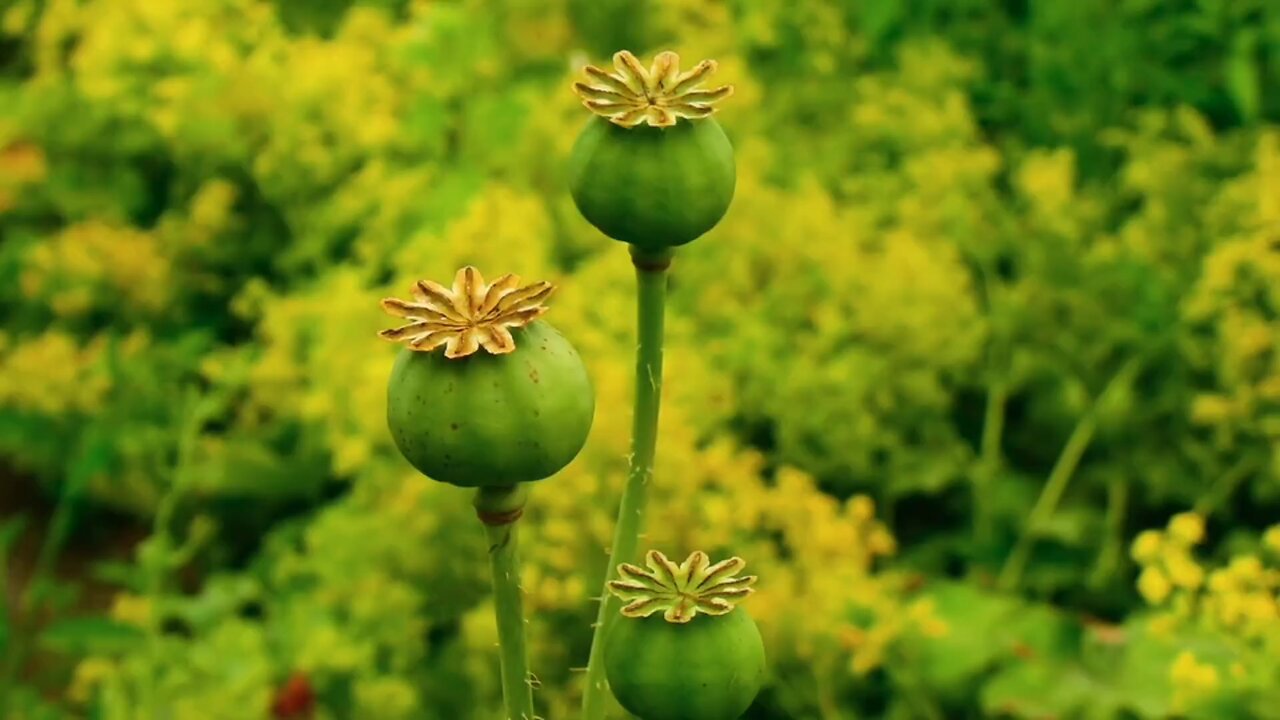Premium Only Content

"The Opium Poppy Capsule: A Botanical Powerhouse"
The opium poppy capsule is a fascinating part of the *Papaver somniferum* plant, both for its botanical significance and its historical and medicinal uses. Here’s a detailed overview:
### **1. Structure and Development**
- **Shape and Size:** The opium poppy capsule is a spherical to ovoid structure that develops after the flower petals fall off. It typically ranges from 2 to 6 cm in diameter.
- **Exterior:** The surface of the capsule is smooth, and it’s often green when immature, transitioning to a brownish or grayish color as it ripens.
- **Interior:** Inside the capsule, there are several compartments or chambers, each filled with tiny seeds. These seeds can range in color from white to blue-black, depending on the variety of the poppy.
### **2. Latex Production**
- **Latex:** The capsule produces a milky fluid called latex, which is rich in alkaloids. When the capsule is scored or incised, this latex oozes out and gradually dries into a sticky, brownish substance known as raw opium.
- **Alkaloids:** The latex contains several alkaloids, the most notable of which are morphine, codeine, and thebaine. These compounds are the active ingredients used in the production of various narcotic drugs.
### **3. Harvesting Process**
- **Incision:** Traditional opium harvesting involves making shallow cuts around the unripe capsule, typically in the evening. The latex seeps out overnight and is collected the next morning.
- **Collection:** The dried latex is carefully scraped off the capsule and collected for further processing. This raw opium can then be refined into different drugs.
### **4. Uses**
- **Medicinal:** Historically, the opium extracted from these capsules has been used for its analgesic (pain-relieving) properties. It has been a key ingredient in medicines like morphine and codeine.
- **Culinary:** The seeds contained within the capsule are not narcotic and are widely used in cooking, especially in baking, for their nutty flavor.
- **Ornamental:** Dried opium poppy capsules are often used in floral arrangements and crafts for their unique and aesthetically pleasing appearance.
### **5. Cultural and Historical Significance**
- **Historical Use:** The opium poppy has been cultivated for thousands of years, with evidence of its use dating back to ancient civilizations in Mesopotamia, Egypt, and Greece.
- **Cultural Impact:** Opium derived from poppy capsules has played a significant role in global trade, medicine, and even conflicts, such as the Opium Wars between Britain and China in the 19th century.
### **6. Legal and Ethical Considerations**
- **Regulation:** Due to its potential for abuse, the cultivation of *Papaver somniferum* and the production of opium are heavily regulated in most countries. It’s illegal to grow opium poppies for the purpose of producing narcotics in many regions.
- **Ethics:** The use of opium and its derivatives raises significant ethical concerns, particularly regarding addiction and the global opioid crisis.
The opium poppy capsule is a remarkable botanical structure with a complex history and significant impact on medicine, culture, and society. If you need more detailed information on any specific aspect of the capsule, feel free to ask!
-
 29:08
29:08
The Lou Holtz Show
8 hours agoThe Lou Holtz Show Ep 21 | Enes Kanter Freedom: A Voice For Human Rights #podcast
4.61K -
 28:31
28:31
America First Policy Institute
16 hours agoAmerica First Policy Institute Gala Donald Trump, Elon Musk & Sylvester Stallone Ignite the Movement
1.91K -
 4:36
4:36
BIG NEM
6 hours agoThe Sad Truth About How Our Cannabis is Grown
2.08K2 -
 LIVE
LIVE
Price of Reason
11 hours agoMainstream Media FEARS Extinction! Gladiator 2 Review! New DnD SCANDAL!
3,809 watching -
 LIVE
LIVE
Fresh and Fit
7 hours agoIsrael-Hezbollah Ceasefire & Reacting To Death Threats On X
5,872 watching -
 1:11:10
1:11:10
Steve-O's Wild Ride! Podcast
5 days ago $8.70 earnedDusty Slay Went From Selling Pesticides To Having A Netflix Special - Wild Ride #244
27K3 -
 1:16:02
1:16:02
CocktailsConsoles
5 hours agoBE PART OF THE GAME!!| Death Road to Canada | Cocktails & Consoles Livestream
19K1 -
 LIVE
LIVE
Phyxicx
7 hours agoWe're streaming again! - 11/26/2024
187 watching -
 LIVE
LIVE
GamingWithHemp
6 hours agoHanging with Hemp #103
1,289 watching -
 21:24
21:24
DeVory Darkins
1 day ago $10.23 earnedElon Musk and Tucker Carlson SHATTER Left Wing Media
36.5K35